
|
Strolling through the crude cement floored halls with their high ceilings, linked to each other by narrow rough hewn passages, it’s rather less of a struggle to imagine what life must have been here all those years ago as compared to the ruined states of many such similar palaces strewn across the country. At the City Palace of Udaipur, one can indeed catch an occasional peep of faded murals, or a piece of inlaid wall once studded with precious stones now long gone, thus making it a touch easier to believe that this immense palace was, in the past, a stronghold of great luxuries and riches with a lot still pretty much around to be witnessed because until quite recently the entire palace had been the home of the state’s royal family.
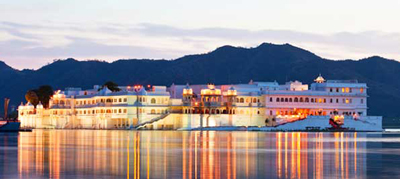 Set by the Lake Pichola, the Udaipur Palace stands tall and proudly true to the prophecy that it can never be conquered through its existence. Yet surprisingly the palace is rather ugly, and is perhaps better described as a palace complex, for this massive structure is actually a large cluster of smaller structures built over the years by various rulers. Part of it is open to the world to showcase some of the treasures it once owned including it’s large grounds where in yesteryears the king often deigned to meet his praja. Also open to public are the remnants of its hanging gardens where the Maharana or great warrior as the king of Udaipur is exclusively addressed, spent stolen moments with his many queens. The huge elephant stables, the grand halls, all give glimpses of the regal world that once was. Set by the Lake Pichola, the Udaipur Palace stands tall and proudly true to the prophecy that it can never be conquered through its existence. Yet surprisingly the palace is rather ugly, and is perhaps better described as a palace complex, for this massive structure is actually a large cluster of smaller structures built over the years by various rulers. Part of it is open to the world to showcase some of the treasures it once owned including it’s large grounds where in yesteryears the king often deigned to meet his praja. Also open to public are the remnants of its hanging gardens where the Maharana or great warrior as the king of Udaipur is exclusively addressed, spent stolen moments with his many queens. The huge elephant stables, the grand halls, all give glimpses of the regal world that once was.
A part of the palace is still home to the present Maharana and one can only assume that its privacy retains a true depiction of the grandeur once believed to have belonged to the entire palace. And yet a third part of the palace has been converted to a grand hotel offering guests a peephole experience of living like royalty. The Taj Lake Palace, set right in the middle of the Pichola Lake and just a few minutes away by boat from the Udaipur Palace, provides the opportunity to yet again experience the regal flair once enjoyed only by kings. An authentic palace and once the summer home of the Udaipur kings, the halls, the central courtyards and the suites of the Lake Palace are dressed in true Rajput style with marble latticed windows in age-old turrets, depicting the opulence of a bygone era still kept alive by one of India’s largest luxury hotel chains, the Taj Group of Hotels. Just a little further from the Lake Palace, again in the middle of the lake and set upon natural rock is the Jagmandir. The original lake palace, this mini-complex, quite an island on its own be it a miniscule one, with a marble walkway and attractive pavilions, is better known as the hideaway of the famous Mughal ruler Shah Jahan when exiled by his father the then ruler and way before he became Emperor and of course, much much before he built India’s masterpiece, the Taj Mahal. Looking up from the city palace and a little to it’s right, one can see, nestling high and above the city, standing alone and seemingly abandoned, the royal Monsoon Palace. The royal haunt when the rare rains lashed across the countryside, this palace is near ruins and it’s a far greater call to imagination to envision what life must’ve once been like here during the good old days of Indian Raj. But folklore claims it had once been a beehive of activity, when the King and his favored cohorts took to holidaying here, enjoying fine cuisines, arts and glorious sunsets. Set in the middle of expansive deserts, this city of lakes where the lakes are dry part of the year, is a rare and nostalgic commemoration to the aesthetic luxuries once enjoyed by India’s finest, with its rare architecture, historical tales, rustic arts and colorful existence. Udaipur is a small city in Rajasthan and is connected by air, rail and road. There are daily flights from all major cities to this popular tourist destination.
As I stood there under the unrelenting gaze of the 10 am scorching sun, my skin reddening to a faint simmer in the blistering heat, I made a mental note to myself that all future sightseeing trips in this part of the country be regulated to prior 9 in the morning or after 5 in the evening. But soon, the blissful immunity that curiosity creates for everything else but the object concerned thankfully took over, as the guide led me across smoldering sands to stare up huge boulders of exquisitely carved solid rock. The Five Rathas. A famed feature of Mahabalipuram also known as Mamallapuram, one of Chennai’s popular heritage sites just an hour’s drive from the bustling city. Once believed to have been atop high rocky hills, Mahabalipuram is now a popular beach, badly hit by the 2004 Tsunami yet still holding strong, and renowned the world over for its ancient Shore Temple, an early example of monolithic architecture, carved solely and completely from rock, standing sentinel over a tall cliff. This elegant structure once served as a lighthouse centuries ago with a single penetrating beam of sharp light magically created from the collective reflection of mere lit oil lamps.
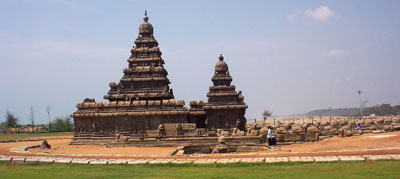 Classified as a UNESCO World Heritage site and apparently initiated by the Pallavas yet forced to be discontinued due to ongoing wars, the Five Rathas is popularly believed to have been commissioned to represent the various preferred choices of transport of favored Hindu deities including Lord Shiva and Lord Vishnu. Other local beliefs also stand strong and as the massive granite monoliths loom before me, the intricate carvings on each detailed the mythical ratha or chariot it depicted, felicitating the expert artwork of perhaps hundreds of skilled artisans. Five separate structures including the sculpture of the holy Nandi stand with pride, each named after the five Pandavas and Draupadi and is locally believed to be depictions of their chosen chariots. Each carved wonder stands as a separate temple yet unfinished thus unconsummated. As I stroll around each structure, lightly touching the surprisingly cool stone despite the biting heat, carved balances of the feminine form with man, of Shiva with his beloved Parvathi, depicted as equal halves of one, stand out and I wonder of Dravidian beliefs on the heated topic of today, of equality between the sexes.
Classified as a UNESCO World Heritage site and apparently initiated by the Pallavas yet forced to be discontinued due to ongoing wars, the Five Rathas is popularly believed to have been commissioned to represent the various preferred choices of transport of favored Hindu deities including Lord Shiva and Lord Vishnu. Other local beliefs also stand strong and as the massive granite monoliths loom before me, the intricate carvings on each detailed the mythical ratha or chariot it depicted, felicitating the expert artwork of perhaps hundreds of skilled artisans. Five separate structures including the sculpture of the holy Nandi stand with pride, each named after the five Pandavas and Draupadi and is locally believed to be depictions of their chosen chariots. Each carved wonder stands as a separate temple yet unfinished thus unconsummated. As I stroll around each structure, lightly touching the surprisingly cool stone despite the biting heat, carved balances of the feminine form with man, of Shiva with his beloved Parvathi, depicted as equal halves of one, stand out and I wonder of Dravidian beliefs on the heated topic of today, of equality between the sexes.
Obviously a chosen land of the gods was the thought that flitted through my mind as a little further on I gazed at the naturally precariously balanced massive ball of rock, known as Krishna’s Butter Ball believed to have held its own against storm and battle through long years. Faint influences of Buddhism can be seen in the huge wall of intricate carvings apparently depicting Arjuna’s prayers before leading the war that defeated all wars, and amidst it all, tucked at the very bottom is the deer that made its way to the face of the Indian rupee. Perhaps it’s the abounding breathtaking craftsmanship that literally blew my mind, craftsmen that, centuries ago, understood dual perspectives, cleverly carving a suckling calf that could be visualized as a fondling deer, depending on the perspective of the viewer. Returning to the welcoming luxury of Radisson’s Temple Bay, the sprawling resort with its spacious rooms and fabulous meandering pool allows you to relax and relish experiences of past’s greatness in the glorious lap of nature. I wait patiently for the sun to lower its haughty stance before sinking into the warm lapping waters of the totally private pool of my elaborate suite. That evening, languid from luxuriant waters, and refreshed with visions of great art, I bask in the ethereal view of the Shore Temple in the near distance as I enjoy a quiet dinner at Temple Bay’s seaside restaurant and suddenly I feel conscious, conscious of being within the sight of gods, gods that chose this small village to be cherished in and I feel graced to have taken the opportune to be a part of this unique place if only for a while.
And finally I too joined the elite club of the very lucky very few who’ve been
fortunate enough to experience the rare and blessed opportunity of true love at
first sight. The highly acclaimed sensations that claim to refresh life and which
sends delicious thrills tingling down your spine, which sweeps your breath right
out of you and leads you to discover yourself longing to capture and experience
these sensations forever, were truly nothing less than a revelation. As we drove
down narrow cobbled streets fringed with age-old trees on either side, I felt my
heartbeat quicken rapidly, and as the tall imposing buildings with their carved
facades looked down upon me I knew I was in love. No other place could possibly
fascinate me more. I yearned to learn of the many tales these structures would
have surely witnessed through the long centuries of their existence. From rich
tales of the famed lives of abounded royalty to the horrific etchings of one of
the greatest bloodiest revolutions ever, Paris has known it all and still stands
tall and proud to tell it all. Here I was, right in the middle of Champs Elysee ,
staring straight ahead, beyond the corner store of Louis Vuitton to behold Arc
de Triomphe. It can only be in the world’s oldest famed city that monuments
honoring brave dead rub shoulders with glamorous brands as scores of people
casually walk on.
 The Louvre was yet another revelation. Walking across impeccable gardens that
resound in the past’s brilliant glories with its many marble statues and exotic
plants and trees that had been brought in from across the world to suddenly
come upon spectacular modernity as an immense glass triad stands right in the
center of the palace’s courtyard inviting you to venture into its rich being. Try
as one may it is barely possible to even imagine that the wide marbled corridors
that stretch across the belly of this enormous edifice leading to its many
treasures had once been the palace’s notorious and much dreaded dungeons
where many poor souls were known to have been abandoned and forgotten. But
now, the Louvre, perhaps in repentance of the mindless savagery it had been
forced to witness during its glorious past, has dedicated its existence to honoring
artistry of all ages,.
The Louvre was yet another revelation. Walking across impeccable gardens that
resound in the past’s brilliant glories with its many marble statues and exotic
plants and trees that had been brought in from across the world to suddenly
come upon spectacular modernity as an immense glass triad stands right in the
center of the palace’s courtyard inviting you to venture into its rich being. Try
as one may it is barely possible to even imagine that the wide marbled corridors
that stretch across the belly of this enormous edifice leading to its many
treasures had once been the palace’s notorious and much dreaded dungeons
where many poor souls were known to have been abandoned and forgotten. But
now, the Louvre, perhaps in repentance of the mindless savagery it had been
forced to witness during its glorious past, has dedicated its existence to honoring
artistry of all ages,.With its immense collection of rare art, one could spend days on end admiring the greatness of great talents from the vast display of exquisite original creations. The huge gallery of sculptures lead on to the private boudoirs of Napoleon III and as one strolls through these high ceilinged rooms, clad with regal chandeliers, heavy silken brocade curtains, gold leafed furniture and gold crusted walls one could imagine the magnificence the palace had owned in its heyday. The great arts housed in the many museums of this city seem to spill over into the streets of Paris as one strolls by the languid Seine. The huge boulders of delicately carved beings look down upon you from atop age-old structures and gardens and it doesn’t take much effort to imagine young noble damsels strolling by in their carousels and frills across green lawns with shady trees over fresh scented flowers. A slow boat ride down the Seine transports one back through many centuries as the city’s historical landmarks dating way back to Gothic ages take their place by her side.  And talking of Gothic, the halo of spirituality that surrounds the Notre Dame
could not possibly be created by any ordinary human hand and must’ve surely
inspired every visitor who steps beneath the carved depiction of the last supper
and through her aged wooden doors to witness a sense of holiness and almost
every head bows in prayerful reverence as the faith of hundreds of years is felt in
the statues, paintings and even the walls around you.
And talking of Gothic, the halo of spirituality that surrounds the Notre Dame
could not possibly be created by any ordinary human hand and must’ve surely
inspired every visitor who steps beneath the carved depiction of the last supper
and through her aged wooden doors to witness a sense of holiness and almost
every head bows in prayerful reverence as the faith of hundreds of years is felt in
the statues, paintings and even the walls around you.Many have spoken of the magnificence of the Eiffel Tower, as one of the greatest wonders of human technology, perhaps I see things differently, for though I can’t help but acknowledge the immense efforts and engineering brilliance that made the Eiffel Tower, what really struck me to the core was the fabulous view right from the very top of the tower. A view that stretched on and on across the great palaces and sprawling gardens, across the gliding Seine and past the many many monuments and statues and bridges and so much more that altogether live to make Paris a great city and the Eiffel Tower stands high as it’s crowning glory providing a vision that would never have been seen or known if not for its existence. And then, just as you begin to feel a little too overwhelmed with yesterday’s magnificence around you, there’s always just the right spot around almost every street’s corner, for you to just sit, take a deep breath and slowly return to the present. Lazing at any of the multitudes of street cafes that dot the corners of every Parisian street with their small tables set right out on the pavements, sipping chilled wine and gorging yummy breads while the world passes by was a pleasure I would grab at every opportunity at least to allow my senses imbibe and swallow every sight and sound I had witnessed. And as it all sinks in, I feel different, changed, and discover that I cannot withhold myself but must speak of it all, all that I had felt and understood of one of the greatest cities ever.
As I stood there staring up at the sparkling edifice that was the world’s greatest declaration of the greatness of love, the drone of the guide barely struck my consciousness for all I could think was, rather unromantically, totally awe-inspiring amazing symmetry!
History has it that the Taj Mahal, a spectacularly glorified tomb, had been built by a woeful husband in memory of his much beloved wife, wanting their love to be embellished in time forever. Legend has it that the love they shared was electrical throughout their married lives until she succumbed to the beck of death bearing his thirteenth child on battleground where she’d accompanied him, apparently unwilling to be apart from him even at war yet eventually unable to fight the inevitable separation caused by ever conquering death. 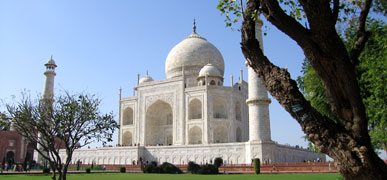 As you stroll into the grounds from under the high arches of the high elegant entrances, a sense of calm envelopes you. A stretch of fountains bedeck sprawling green gardens shadowed by great willowy trees and lead straight to the massive domed structure seemingly supported by four independent and almost equally high pedestals, and you can’t help but wonder how it could have been possible for mankind to have built such magnificence with the richest best from all across the world, especially at a time when transportation was hardly progressive. As you stroll into the grounds from under the high arches of the high elegant entrances, a sense of calm envelopes you. A stretch of fountains bedeck sprawling green gardens shadowed by great willowy trees and lead straight to the massive domed structure seemingly supported by four independent and almost equally high pedestals, and you can’t help but wonder how it could have been possible for mankind to have built such magnificence with the richest best from all across the world, especially at a time when transportation was hardly progressive. I guess that’s the power of love, yet again, all this in the name of love?? The architectural brilliance of the Taj Mahal is perhaps often lost on the common and untrained eye which merely sees the immense gleaming marble surfaces adorned with intricate carvings endowed with precious stones and passages from the Quran festooning the exterior walls in black onyx set in decorative font and of course, all that in itself is no minor feat that proclaims the talented skills of craftsmen of that age, yet what really grabbed my attention was the strength of symmetry throughout the entirety of this immense composition. Whichever way you would turn, whichever way you would look, the symmetry of the entire complex from every angle was impeccably unfailing. And one starts to believe that perhaps the legend is actually true, that the architects had their thumbs cut off to prevent the creation of another such greatness. Standing at the faux tombs of Shah Jahan and his beloved Mumtaz, their actual beings buried in the floor beneath but shielded from the public eye, I couldn’t help but wonder how the love between two people, be it King and Queen, could result in such elaborate opulence. Was it really love that lead to all this? How can the love of one man for his dead wife be measured in long hard years and painful efforts of hundreds? But merely looking through the center of the latticed marble frame that surrounds the tombs one could see that your line of vision runs right through the center of the entire complex right to the dot. In fact if a line were to be drawn from where I stood between the tombs to the high entrance yonder then the line would run right through the center of the fountains, that stood between the tomb and its entrance, and would cut the entire complex into two perfect halves. And all this was built at a time when there were none of the design software and computers or complex instruments of today, but merely on the strength of the brilliance of human ability and intelligence. And focused dedication I had to admit as well, for whatever the eventual senile intentions of the mourning King, he had succeeded in creating one of the world’s greatest wonders, and what better than to be inspired by the thought that it had all been in the name of love? For though the grandeur that surrounded me had me breathless, my heart still stubbornly refused to believe that it was indeed a work of love. Perhaps it had been initiated as such yet somewhere down the road intentions and purposes had shifted. And though what resulted is today one of the greatest tales of the ability of man, it was obvious that the creator had been out to make history be it in the name of love, especially when across the river on whose banks the Taj Mahal proudly stood, is the ancient site that possesses the beginnings of yet another tomb, apparently for the King himself, intended to be built and readied during his lifetime, rumor claiming that it was to be in black marble, a male repartee to the white purity of the Taj Mahal, however, his plans were crushed and the site still stands abandoned as it had been when his own son had him imprisoned in the palace nearby, and perhaps rightly so and maybe just in the nick of time as royal coffers were dangerously emptying from the lavishness unleashed in creating the Taj Mahal. It is said that Shah Jahan lived the rest of his life in a luxurious tower that faced the Taj Mahal, and apparently when he took his last breath his eyes closed forever over a last look at his beloved’s resting place. And thus as the tales grew and through the years came to be believed as truth, the Taj Mahal finally came to be known through the world as the avowal of one man’s undying eternal love, the relentless labors of many laborers from all over, even from across the seas, lay lost from appreciation, for though the dream was of one man’s the realization was by hundreds of others.
Strands of vague yet lingering memories of an aged yet grandiose durbar hall and winding narrow passages that lead from dank corridors to palatial rooms adorned with mystic paintings and ethereal murals is probably what eventually led me back to Mysore palace after a decade and half.
Standing at the huge arched entrance and taking in a full view of the palace from across its grounds, I could only be glad I came back, for now I could once again enjoy the magnificence of this regal structure with its many pink marble domes and multiple arches that grace its façade. And this time I could understand its vivid history a bit better than a naïve schoolgirl who could only be awed by the palace’s beauty and nothing much more.  What struck me most, then and now, was perhaps its rare architecture, for most archaic structures across India are more or less clearly defined in terms of period, style and design but this palace, one of the largest in the country, seems to be a curious blend of Hindu, Muslim, Rajput and even Gothic styles of architecture! What struck me most, then and now, was perhaps its rare architecture, for most archaic structures across India are more or less clearly defined in terms of period, style and design but this palace, one of the largest in the country, seems to be a curious blend of Hindu, Muslim, Rajput and even Gothic styles of architecture! Apparently history has it that this palace including the ancient fort it stands securely within was once demolished from these very same grounds by the famed warrior ruler Tipu Sultan to provide material for the construction of a new fort nearby. In those days, Tipu Sultan followed the smart, fast and easy method of using existing structures to build structures of his own in the wake of his conquests across the country. It is known that he even destroyed temples and used the materials from them to build mosques; of course he ensured that all images including those of gods and goddesses, which were often carved on the pillars and walls of the temples, were defaced and destroyed completely before the material was reused. Anyway, coming back to Mysore palace, with the entry of the English in the foray, the Wodeyars, original rulers of this southern state, were reinstated to the throne and the fort Tipu Sultan took pains to build was brought down and its materials were then and yet again used to once more build the Mysore palace! Thus it can be quite literally stated that the Mysore palace had come full circle! Of course it did get burned down a couple of times with lightening strikes and accidental fires during the long course of its existence, right from somewhere in the 14th century when it was believed to have first been constructed and mostly in wood. But facing all odds, the palace survived every catastrophe one way or another, only to emerge standing tall and proud till this day. My favorite part of the palace and perhaps the favorite of many who’ve visited Mysore palace is the grand durbar hall also known as the Kalyana Mantapa. A huge octagonal shaped hall themed on peacocks, the beauty of this room is the freshness of its colors, highlighted by a magnificent stained glass ceiling set with peacock motifs still gloriously and colorfully bright despite the long years of its existence. Below this great and colossal piece of detailed art is the tiled floor, again set in vivid peacock themed mosaic. The stained glass is from Scotland and the tiles are all English. The walls that define the hall however are very Indian and are bedecked with murals and paintings depicting regal festivities and royal processions of the glorious years that had been and are still rich in color as though splashed with a fresh coat of paint just yesterday. 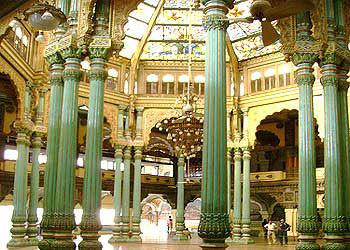 The Ambavilasa, the palace’s second smaller durbar hall follows a close second as my favorite, with its magnificent doorway of carved rosewood inlaid with pure ivory, its lavishly gilded pillars, elaborate floral chandeliers and artfully embedded mosaic floor embellished with precious stones. Apparently the king’s preferred room for private audiences, this spectacular hall also carries forth another version of the stained glass ceiling featured in the larger durbar hall, but here refinement in terms of luxury deliver impressions of boundless richness that can only be experienced in a real palace.
The Ambavilasa, the palace’s second smaller durbar hall follows a close second as my favorite, with its magnificent doorway of carved rosewood inlaid with pure ivory, its lavishly gilded pillars, elaborate floral chandeliers and artfully embedded mosaic floor embellished with precious stones. Apparently the king’s preferred room for private audiences, this spectacular hall also carries forth another version of the stained glass ceiling featured in the larger durbar hall, but here refinement in terms of luxury deliver impressions of boundless richness that can only be experienced in a real palace. The armory exhibited in the palace give one a fairly good idea of the sophisticated yet practical thinking that went into creating some of the armor, revealing the stature a good weapon possessed in those days. Mysore Palace is said to be adorned to its grandest during Dessehra, Mysore’s favorite festival. Ablaze with myriad lights that define its every facet, the Palace is aglow at night every night through the festival whose ostentatious procession partaken by the king himself is its greatest spotlight. Strolling barefoot through the many rooms of this historical palace gives one the sensation of stepping back in time, to the days when the palace would be bustling with the household activity of a King in state and not noisy tourists! Yet, even today, one can sense the reverence that reverberates through every visitor as he steps through the many temples that are a part of the palace. One can see the awe on the faces of young children as they stare up at the splashes of amazingly lively colors of the durbar hall’s ceiling and you are glad, glad that a visit to this wonderful palace that can only be called a grand work of gifted art will remain as lingering memories in the hearts of many others as well.
Cool October breeze bears forth sweet scents of rich fruit.
Dense vines stretch on and on beyond eye’s reach on either side of the long narrow strip of road. 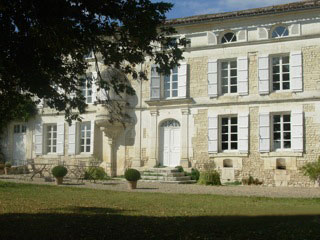 With just the occasional car passing us by, it seemed as though all of nature’s glory was ours alone to behold and enjoy on the long drive to a tiny, seemingly forgotten village snugly tucked away in the famed folds of the French countryside, yet still known the world over for its renowned gift to mankind. With just the occasional car passing us by, it seemed as though all of nature’s glory was ours alone to behold and enjoy on the long drive to a tiny, seemingly forgotten village snugly tucked away in the famed folds of the French countryside, yet still known the world over for its renowned gift to mankind. The thick bushes, pregnant with lush fruit are spread across the wide plateaus and low hills that are invariably dotted with tiled homes and barns of age-old farming families who have tendered these lands with fevered reverence for generations. And suddenly the realization strikes that in Cognac, dedicating life to the creation of rare fine wines was indeed the favored way of life. The drive took us back in time or perhaps merely to another land, but definitely a faraway fairytale land that rekindles emotions long believed lost, for as we drove slowly into the town I felt almost childish sensations of awe and excitement sweep over me.  Later I strolled down paved streets, that have obviously stayed stoic for many long years, decked on both sides with quaint shops welcomingly presenting warm breads, fresh flowers and young wines on the ground level while above each store, on the upper floors, with their colorful flowered pots on window sills and lazily fluttering lacy curtains were obviously cozy homes, I reckoned that for one used to the modern dreariness of city existence, Cognac was certainly an enchanted land come true to life!
Later I strolled down paved streets, that have obviously stayed stoic for many long years, decked on both sides with quaint shops welcomingly presenting warm breads, fresh flowers and young wines on the ground level while above each store, on the upper floors, with their colorful flowered pots on window sills and lazily fluttering lacy curtains were obviously cozy homes, I reckoned that for one used to the modern dreariness of city existence, Cognac was certainly an enchanted land come true to life!Most of the entire entirety of the village is ages old and nearly every street eventually leads to the cobbled square that centers Cognac’s quaint little town. Circling the square are the popular ever-present French cafes interspersed with fine-dining restaurants, wine shops, wine shops and more wine shops! Walking down its few streets you shouldn’t be surprised to find stores sporting premium labels, a minor revelation of Cognac’s heady success over the years as its wine established itself as the world’s favored aperitif. 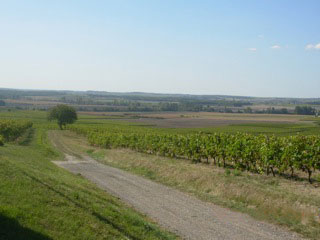
There are quite a few choices for stay, some right in the village but we finally picked a boutique hotel, apparently once a noble chateau, nestled deep in a valley of vineyards on the outskirts of the village. With just eleven rooms that retain every charm of its original grace, the Logis Du Fresne is run by a warm and extremely friendly young couple that enjoys discovering such ancient homes, renovating them and then opening their doors for others to enjoy as well! Visiting vineyards, walking down ripe rows of vines, inhaling nature’s freshness, tasting grapes straight from the bush and then, witnessing tedious plucking now made easy with the brilliance of modern technology as machines steadily prod on, confidently picking the grapes while ensuring the vines remain safe and strong is a must-have experience. 
Proud families sport wines, young and aged, in bottles with labels sporting family titles and it’s hardly surprising that almost every member of each family contributes to the making wine, eventually their collective livelihood. Learning the process of double distillation in quaint yet ethnic distil pots that solely belong only to Cognac one understands the proud possessiveness the natives retain over their wines. Minute detailing is given to every moment of creativity, right from the classification of the soil, to the vine’s health, to the grape’s character, to the fine distillation, then the bottling, the aging and finally to conclude with the eventual exclusive character the wine owns, a character distinct solely to this tiny village of France that leaves not just the whole world but especially its visitors inebriated with much more than the wines it produces, for Cognac the town is as intoxicating or perhaps even more so than the cognac it creates!
Planning a holiday with the family? Or rather, planning your very first family holiday abroad? Then think no more, Singapore is definitely the place to be!
At one single shot, your family gets a huge whiff of international living complete with skyscrapers, subways, sprawling malls, and unbelievable cleanliness! Added to that, there's so much for the kids too! 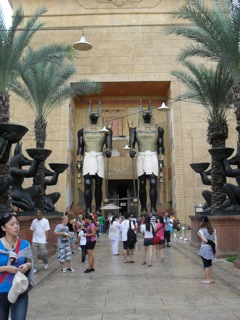 Personally my kids freaked out at the famed movie theme park, Universal Studios, one of the main reasons I chose to take them to Singapore. The whole trip was worth just seeing the thrilled looks on their faces as they walked through the life-sized sets of some of their favorite movies, shook hands with a couple of giant sized toons, witnessed how some great film scenes are actually made and screamed their lungs out on the popular Mummy ride! In fact, they didn't skip a single ride and the elder one even had a go on the huge rollercoaster, she enjoyed it thoroughly but needless to say her reluctant partner for the ride, her dad, didn't!
Personally my kids freaked out at the famed movie theme park, Universal Studios, one of the main reasons I chose to take them to Singapore. The whole trip was worth just seeing the thrilled looks on their faces as they walked through the life-sized sets of some of their favorite movies, shook hands with a couple of giant sized toons, witnessed how some great film scenes are actually made and screamed their lungs out on the popular Mummy ride! In fact, they didn't skip a single ride and the elder one even had a go on the huge rollercoaster, she enjoyed it thoroughly but needless to say her reluctant partner for the ride, her dad, didn't!The park isn't just fun for kids, but is an awakening for the kids in all of us as well. I loved the Mummy theme, its ride had me breathless long after I got off it! And the 3D Shrek show was pretty cool too. And then of course, there's the food!! There are umpteen choices of varied cuisines including regular local favorites, and for those who don't want to waste time sitting at a table for a meal, you can always grab a juicy hot turkey leg from one of the innumerable stands that dot the entire park. When in Singapore, a day at Sentosa should definitely be on the charts as well. Try the cable car ride into this idyllic island, the view is to die for, as you leave steeped and a couple of oddly shaped buildings behind, to ride above the port that allows a peek at the many luxury ships and yachts docked out beneath. What you get to do at Sentosa is a whole different story on its own. Kids and adults alike are sure to love the tour at the Underwater World, with the rare sight of sharks gliding overhead! And of course, you should try a hand at feeding the stingrays, the only rider being that you have to buy the feed to feed the fish. The dolphin show is always a huge hit with kids. And so is the Desperados show in 3D. I wouldn't recommend the butterfly garden, it can be a bit of a bore, skip the Fort Siloso if you aren't a history buff, and if you've done the cable car ride then I'd suggest you drop the Merlion Tower as well, there's nothing much to it and frankly the view from the top just isn't as great. However, the luge ride is great fun. In fact, I enjoyed it so much I took a couple of rounds at it! If you're into beaches then there are quite a few to choose from to just chill by or take a lazy dip. But most of all, be sure not to miss the grand finale to each day, the amazing fire and light show, it's just the perfect end to a fun-filled day. 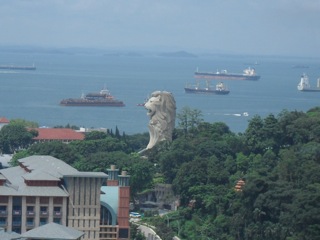 Other great highlights of the holiday were feeding the richly colored birds at the Jurong Bird Park and a shot at animal nightlife at the night safari.
Other great highlights of the holiday were feeding the richly colored birds at the Jurong Bird Park and a shot at animal nightlife at the night safari.
And now I come to my favorite part of the trip, shopping!!! Believe me, nothing can beat Orchard Street, when it comes to glitz and glamour! It's just the place to splurge if that's what you're in for. The street's a bustle of non-stop activity that goes on till quite late into the night. And for a first-timer, time here can be quite awesome, with its stretch of malls on either side, shaded with tall proud trees. And what's more, you don't have to bother about crossing the street as each corner mall is linked to the other side of the street underground! The luxurious of luxury is available here, right within your reach. Honestly you could spend hours, even days here, and it still won't be enough! Of course, a popular haunt for visiting Indians is Musthafa Center in Little India. A huge store, in fact, a mall on its own, the greatest plus of Musthafa is not just that you get almost everything from electronics, to watches, to household necessities and clothes under one roof, but is the fact that it's open 24 hours, so you can shop on and on for as long as you wish. There are umpteen hotels to choose from, but if all you're looking for is someplace safe and comfortable and classy enough then there are a couple of hotels in Little India that should be quite suitable, and I would recommend first-timers to stay in Little India, because with all the Indians strolling around, I'm sure you would feel very much at home. Another huge plus, is the subway system, or the MRT as it's better known in Singapore. Once you get the hang of the routes and the rules, it's the easiest and cheapest way to travel, with stops at almost every spot you'd want to go.  And then there's the food. I enjoy trying out local cuisines when I travel and I normally pick out restaurants that seem popular with the locals, trust me, it's the best and safest way to pick the right place to eat. But be forewarned, not everyone will enjoy the food of another, what is delicious to some can actually be quite repelling to others, so if you would rather play it safe then that's fine too, for Singapore has quite a few authentic Indian restaurants, including this great dosa place just across the corner from Musthafa Center.
And then there's the food. I enjoy trying out local cuisines when I travel and I normally pick out restaurants that seem popular with the locals, trust me, it's the best and safest way to pick the right place to eat. But be forewarned, not everyone will enjoy the food of another, what is delicious to some can actually be quite repelling to others, so if you would rather play it safe then that's fine too, for Singapore has quite a few authentic Indian restaurants, including this great dosa place just across the corner from Musthafa Center.
When in Singapore I would strongly recommend a visit down Clarke Quay as well, especially in the evening. The restaurants here serve delectable fare mostly local and mostly seafood, and the ambience by the river is more than a touch romantic. The nightlife too is great here but not really meant for children, if you get my drift! Singaporeans know the importance of their tourism industry, so wherever you go, be assured you'll be welcomed with friendly smiles and a helping hand. It's a beautiful place to be, even for just a short stay, right from the bright flowers that lead the way from the airport into this remarkable city, there's something about Singapore that makes it markedly different from most cities I've visited. Maybe it's the visible invisibility of police, yet the absolute strong presence of a sense of complete security keeps us feeling safe at any time anywhere here. Maybe it's the almost unbelievable cleanliness that is consistent across every nook and corner of the entire city, a city that even has a ban on chewing gum solely to ensure its cleanliness is maintained in every possible way. So yes, if you're planning that first great holiday across the seas then give Singapore a shot, trust me, you won't be disappointed.
From afar, and in fact even as you drive up close, you would see the strange looming figures seemingly plunged out of nowhere into the midst of sprawling fields, and you probably wouldn’t think anything great about the odd pile of huge stones. But as you walk down the tunnel that opens out into the field and places you right in front of the monument, fascination grabs hold of your attention, and the amazement merely deepens as you circle the structure.
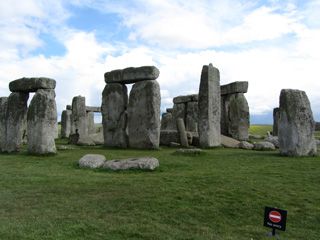 The seemingly randomly placed stones gradually appear to have been placed strategically in positions well planned and calculated by a race of mankind that existed hundreds and hundreds of years ago, to be more accurate around the Neolithic and Bronze Ages or, to be more precise, somewhere between 2200BC and 2400BC, as suggested by the radiocarbon dating of the first stones that were raised on the site.
The seemingly randomly placed stones gradually appear to have been placed strategically in positions well planned and calculated by a race of mankind that existed hundreds and hundreds of years ago, to be more accurate around the Neolithic and Bronze Ages or, to be more precise, somewhere between 2200BC and 2400BC, as suggested by the radiocarbon dating of the first stones that were raised on the site.It is probably as this tremendous realization strikes that you are struck by yet another amazing fact. These huge stones, and I mean, huge as in both bulky and towering, do not belong to the particular area in which they now sit, which is just about a few miles north of Salisbury and an hour and half from London. Instead they are believed to have been brought in from locations up to 240kms away including the quarries of Wales, during an age when the wheel had not yet been born into existence. It is believed that the Stonehenge evolved through various construction phases that spanned over 1500 years. The earliest traces of construction show that the first stones had been placed in a circular bank with a ditch running alongside and a large entrance to the northeast. Several animal bones were found to corroborate that the construction of this particular area of the monument had taken place around 3000BC, a time when man had used honed animal bones as tools. There are traces of evidence that prove that timber too had once been a part of the monument, but today, just a few postholes placed at regular intervals within the site stand as proof for the same. It was during the second phase of construction that the northeast entrance is believed to have been widened to precisely match the midsummer sunrise and the midwinter sunset. The famed Heelstone, that stands slightly away from the circle of stones, and the Slaughter Stone that lies away from the circle as well are believed to have been put in place during the 3rd phase of construction. The wider circle of standing stones with the lintel stones placed atop them are believed to have been placed during the next major construction phase. These huge stones are believed to weigh atleast 50 tons each and are joined together by a complex jointing. And it is this phase that has been radiocarbon dated to 2200BC. The phases of construction that followed saw the altar stone re-erected to stand vertically but basically seemed shoddily done as compared to the earlier phases as the stones placed during this period tended to fall over. The site’s famous horseshoe shaped setting though initially set in place during the second and third phases of construction, gained prominence in the latter stages. Obviously the site of the Stonehenge was apparently of great importance to prehistoric man for some unfathomable reason, as not far from the set of stones, there was found 4 or 5 Mesolithic postholes believed to be dated as far as 8000BC. Produced by a culture that left behind no written records or reasons to their bizarre and prolonged creativity, there are several explanations to the actual existence of the Stonehenge, which when translated means ‘hanging stones’ or ‘supported stones’ or ‘hinged stones’ probably because the stone lintels are hinged onto the upright ones. Anyway, as to why prehistoric man created such a monument, well, many contend that the site was a burial ground from its earliest beginnings and this is given to reason because of the innumerable burial mounds found within the circle of stones and its surroundings. The remains discovered were mostly cremated and belonged to men and women and included some children too. Evidence shows that the underlying chalk at the gravesites had been crushed, thus establishing the reasoning of some archaeologists that the bluestones were initially placed as grave markers. Many have come to believe that Stonehenge had been a prehistoric place of healing, more like an early age Lourdes. While some others believe that the site was multi-functional and stood as a ancient place of worship as well, and probably a temple of sun worship. But the site without doubt includes a celestial observatory function as well. 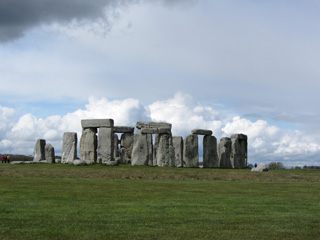 Anyway, putting aside history and facts, Stonehenge has hinged to it several interesting folktales as well, including one that claims it was built by the Devil who had bought the stones from a woman in Ireland and explained the queer placing of the Heelstone was because the stone was thrown by the Devil at a Friar and had hit the latter on the heel! Even more interesting is the tale of how King Arthur commissioned the construction of Stonehenge with ‘healing stones’ sourced from Africa and the construction was undertaken by Merlin who used his wizardly powers to arrange the placement of the stones just so!
Anyway, putting aside history and facts, Stonehenge has hinged to it several interesting folktales as well, including one that claims it was built by the Devil who had bought the stones from a woman in Ireland and explained the queer placing of the Heelstone was because the stone was thrown by the Devil at a Friar and had hit the latter on the heel! Even more interesting is the tale of how King Arthur commissioned the construction of Stonehenge with ‘healing stones’ sourced from Africa and the construction was undertaken by Merlin who used his wizardly powers to arrange the placement of the stones just so!Fact or myth, Stonehenge still stands tall and proud in its place, despite long years or rather, long ages of tempering and meddling. It’s believed that many of the stones that once stood at the site had been removed or cut down by the ignorant to be part of local constructions at the nearby villages, and until not too long ago, visitors would come to Stonehenge and chip away a part of the stones to take back home with them! Yet despite it all, Stonehenge has weathered a weary battle against time and man, so if you’re planning a visit to London, squeeze in a visit to the Stonehenge and allow yourself a trip down centuries to an age where monolith structures were the ultimate in human creative abilities. |

